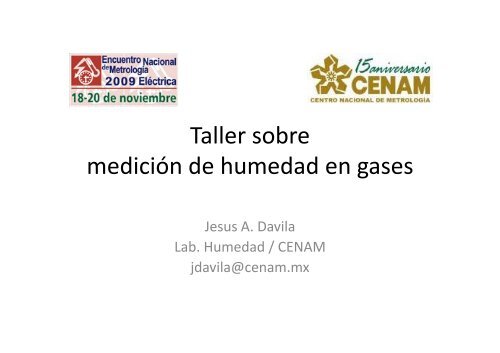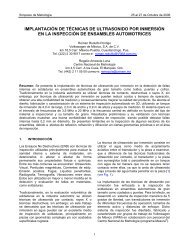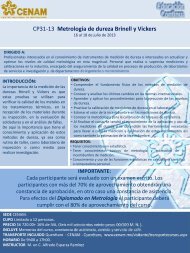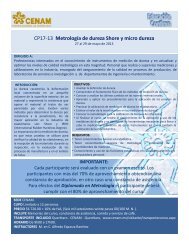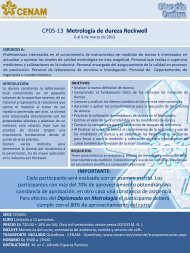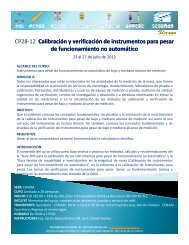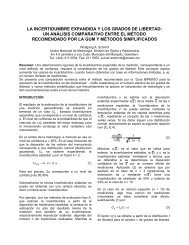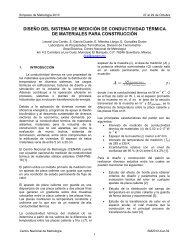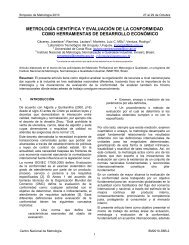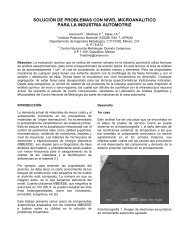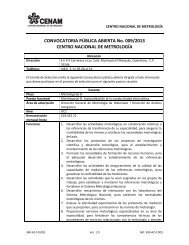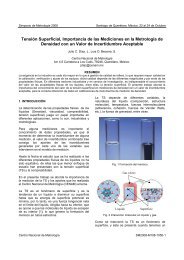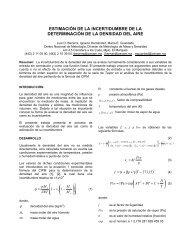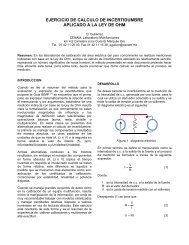Taller sobre medición de humedad en gases g
Taller sobre medición de humedad en gases g
Taller sobre medición de humedad en gases g
Create successful ePaper yourself
Turn your PDF publications into a flip-book with our unique Google optimized e-Paper software.
<strong>Taller</strong> <strong>sobre</strong><br />
<strong>medición</strong> <strong>de</strong> <strong>humedad</strong> <strong>en</strong> <strong>gases</strong> g<br />
Jesus A. Davila<br />
Lab. Humedad / CENAM<br />
jdavila@c<strong>en</strong>am.mx
• Introducción<br />
Cont<strong>en</strong>ido<br />
• Conversión <strong>en</strong>tre <strong>humedad</strong> relativa y temperatura <strong>de</strong><br />
punto <strong>de</strong> rocío.<br />
• Efecto <strong>de</strong> presión <strong>en</strong> la temperatura <strong>de</strong> punto <strong>de</strong> rocío.<br />
• Conclusiones
Conversión <strong>en</strong>tre HR y td
Relación <strong>en</strong>tre las magnitu<strong>de</strong>s g <strong>de</strong> <strong>humedad</strong><br />
Xa<br />
HE<br />
HR rw<br />
Td Tw<br />
rv<br />
Xv<br />
HA<br />
4
Temperatura <strong>de</strong> punto <strong>de</strong> rocío<br />
• Temperatura <strong>de</strong> punto <strong>de</strong> rocío o escarcha<br />
Temperatura a la cual la mezcla gas‐vapor <strong>de</strong> agua<br />
isobáricam<strong>en</strong>te para inducir con<strong>de</strong>nsación o solidificación.<br />
<strong>de</strong>be ser <strong>en</strong>friada<br />
En esta condición, la presión <strong>de</strong> vapor <strong>de</strong> agua alcanza su condición <strong>de</strong> saturación.<br />
T
Medidor <strong>de</strong> temperatura <strong>de</strong> punto <strong>de</strong> rocío
Introducción<br />
• Presión <strong>de</strong> saturación <strong>de</strong> vapor <strong>de</strong> agua: Ecuaciones <strong>de</strong><br />
aproximación para la fase líquida<br />
6 ⎛ i 2 ⎞<br />
e( Td<br />
) = exp⎜∑<br />
aiTd<br />
+ a7<br />
lnTd<br />
⎟,<br />
⎝<br />
⎠<br />
−<br />
⎝ i= 0 ⎠<br />
Wexler (1976,<br />
1977)<br />
Sonntag (1990) Hardy (1998)<br />
a0 -2,9912729.103 0 -2,8365744.103 a1 -6,0170128.103 -6,0969385.103 -6,028076559.103 a2 1,887643854.101 2,12409642.101 1,954263612.101 a3 -2,8354721.10-2 -2,711193.10-2 -2,737830188.10-2 a4 1,7838301.10-5 1,673952.10-5 1,6261698.10-5 a5 -8,4150417.10-10 0 7,0229056.10-10 a6 4,4412543.10-13 0 -1,8680009.10-13 a7 2,858487 2,433502 2,7150305<br />
U r (e(T)) ≤0,005%<br />
0ºC ≤t ≤ 100ºC<br />
≤0,005%<br />
0ºC ≤t ≤ 100ºC<br />
<strong>en</strong><br />
Pa<br />
≤0,005%<br />
0ºC ≤t ≤ 100ºC
Introducción<br />
• Presión <strong>de</strong> saturación <strong>de</strong> vapor <strong>de</strong> agua: Ecuaciones <strong>de</strong><br />
aproximación para la fase sólida (hielo)<br />
e(<br />
T<br />
f<br />
)<br />
⎛<br />
⎞<br />
,<br />
6<br />
i 2<br />
= exp⎜∑<br />
aiT<br />
f + a7<br />
lnT<br />
f ⎟<br />
⎝ i 0<br />
⎠<br />
−<br />
⎝ i= 0 ⎠<br />
<strong>en</strong><br />
Pa<br />
Wexler (1976, 1977) Sonntag (1990) Hardy (1998)<br />
a 0 0 0 0<br />
a 1 -5,6745359.10 3 -6,0245282.10 3 -5,8666426.10 3<br />
a 2 6,3925247 2,932707.10 1 2,232870244.10 1<br />
a 3 -9,677843.10 -3 1,0613868.10 -2 1,39387003.10 -2<br />
6 22157 10 7 1 3198825 10 5 3 4262402 10 5<br />
a4 6,22157.10-7 -1,3198825.10-5 -3,4262402.10-5 a 5 2,0747825.10 -9 0 2,7040955.10 -8<br />
a 6 -9,484024.10 -13 0 0<br />
a 4 1635019 4 9382577 10-1 6 7063522 10-1 a7 4,1635019 -4,9382577.10-1 6,7063522.10-1 U r (e(T)) ≤(0,01-0,005.t)%<br />
-100 ºC ≤t ≤ 0,01 ºC<br />
≤0,5%<br />
-100ºC ≤t ≤ 0,01ºC<br />
≤ (0,01-0,005.t)%<br />
-100 ºC ≤t ≤ 0,01 ºC
Humedad relativa<br />
Coci<strong>en</strong>te <strong>en</strong>tre la fracción molar <strong>de</strong> vapor <strong>de</strong> agua <strong>en</strong> un espacio dado ( x ) y la fracción<br />
molar <strong>de</strong>l vapor p <strong>de</strong> agua g <strong>en</strong> su condición <strong>de</strong> saturación ( x s ). )<br />
HR =<br />
x<br />
x<br />
s<br />
Usando la ley <strong>de</strong> <strong>gases</strong> i<strong>de</strong>ales, la fracción molar <strong>de</strong> vapor <strong>de</strong> agua se pue<strong>de</strong> escribir<br />
como:<br />
x =<br />
e<br />
P<br />
Con P=e+Pa, Pa=presión a <strong>de</strong>l aire seco,<br />
e = presión parcial <strong>de</strong> vapor <strong>de</strong> agua.<br />
,<br />
( 1)<br />
( 2 )<br />
La fracción molar <strong>de</strong> vapor <strong>de</strong> agua <strong>en</strong> su condición <strong>de</strong> saturación (xs), es <strong>de</strong>cir cuando el<br />
vapor <strong>de</strong> agua se <strong>en</strong>cu<strong>en</strong>tra <strong>en</strong> equilibrio con agua pura pura, se pue<strong>de</strong> calcular por medio<br />
<strong>de</strong> la sigui<strong>en</strong>te expresión:<br />
e s x s<br />
P<br />
= P<br />
( 3<br />
)
Humedad relativa<br />
Consi<strong>de</strong>rando que el vapor <strong>de</strong> agua pres<strong>en</strong>ta <strong>de</strong>sviaciones respecto a un gas i<strong>de</strong>al,<br />
resulta necesario realizar una corrección por tal <strong>de</strong>sviación, luego las fracciones<br />
molares <strong>de</strong>b<strong>en</strong> ser corregidas tomando <strong>en</strong> cu<strong>en</strong>ta este efecto.<br />
x =<br />
x s =<br />
f ( P,<br />
T ) e(<br />
T<br />
d ⋅<br />
P<br />
d<br />
)<br />
f ( P,<br />
T ) ⋅ e ( T )<br />
P<br />
s<br />
Finalm<strong>en</strong>te, la <strong>humedad</strong> relativa se pue<strong>de</strong> estimar por medio <strong>de</strong> la sigui<strong>en</strong>te<br />
expresión:<br />
% HR<br />
=<br />
f ( P,<br />
T<br />
,<br />
) ⋅e(<br />
T<br />
)<br />
( 4 )<br />
( 5 )<br />
d d<br />
•100<br />
( 6 )<br />
f<br />
( P,<br />
T ). e(<br />
T )
Ejemplos
Ejemplo 1<br />
En un almacén con temperatura controlada y a una presión <strong>de</strong> 710 hPa<br />
se obti<strong>en</strong>e bti una <strong>medición</strong> di ió <strong>en</strong> temperatura t t d<strong>de</strong> punto t d<strong>de</strong> rocío í d<strong>de</strong> 15°C 1.5 °C y<br />
la temperatura ambi<strong>en</strong>te es <strong>de</strong> 20 °C. ¿Cuál es el valor <strong>de</strong> <strong>humedad</strong><br />
relativa?
Paso 1: calcular e(T) y e(Td)<br />
e(T) = 2 339.26 Pa<br />
e(Td) =6 81 81.138 138 Pa<br />
Paso 2: Calcular %HR<br />
e<br />
Ejemplo 1<br />
⎛<br />
exp⎜<br />
⎝<br />
= ∑ +<br />
−<br />
6<br />
i 2<br />
( Td<br />
) aiTd<br />
a7<br />
lnTd<br />
⎝ ∑ i=0<br />
e(<br />
Td<br />
)<br />
% HR ≈ ⋅100<br />
e(<br />
T )<br />
%HR = 29.12<br />
⎞<br />
⎟<br />
⎠
Ejemplo 2.<br />
Ejemplo2<br />
Calcular la temperatura <strong>de</strong> punto <strong>de</strong> rocío a partir <strong>de</strong> un valor <strong>de</strong> <strong>humedad</strong> relativa <strong>de</strong><br />
20 % a una temperatura <strong>de</strong> 25 °C.<br />
Paso 1: Obt<strong>en</strong>er el valor <strong>de</strong> e(Td)<br />
e(Td) = 633.984 Pa<br />
e(<br />
Td<br />
)<br />
% HR ≈ ⋅100<br />
e(<br />
T )<br />
% HR ⋅e(<br />
T )<br />
e(<br />
Td)<br />
=<br />
100
Paso 2: Calcular td / °C<br />
Ejemplo 2<br />
Aproximación <strong>de</strong> Sonntag para estimar la temperatura <strong>de</strong> punto <strong>de</strong> rocío (0 ºC≤t d<br />
≤100 ºC)<br />
−1<br />
2<br />
−2<br />
3<br />
−3<br />
4<br />
td (º C)<br />
= 13,<br />
715y<br />
+ 8,<br />
4262.<br />
10 y + 1,<br />
9048.<br />
10 y + 7,<br />
8158.<br />
10 y<br />
don<strong>de</strong> y=ln[ e(T) / 611,213 ]<br />
td = 0.5 °CC
Efecto por presión
Temperatura <strong>de</strong> punto <strong>de</strong> rocío / efecto por<br />
presión<br />
x1, P1 x2, P2<br />
e(<br />
td1)<br />
x 1 =<br />
P1<br />
e(<br />
td1<br />
) e(<br />
td<br />
=<br />
P P<br />
e(<br />
td<br />
2<br />
) f ( P , td<br />
2<br />
2<br />
1<br />
2<br />
2<br />
e(<br />
td<br />
x 2 =<br />
P<br />
)<br />
⎛ P ⎞ 2<br />
) = e(<br />
td ⋅ ⋅ ⎜<br />
⎟<br />
1)<br />
f ( P1<br />
, td1)<br />
⎝ P1<br />
⎠<br />
Enrique Martines, Leonel Lira, 2008. “Cálculo <strong>de</strong> la temperatura <strong>de</strong> punto <strong>de</strong> rocío a<br />
difer<strong>en</strong>tes valores <strong>de</strong> presión”. Simposio <strong>de</strong> Metrología 2008.<br />
2<br />
2<br />
)
Temperatura <strong>de</strong> punto <strong>de</strong> rocío / efecto por<br />
presión<br />
P / Pa<br />
800000<br />
700000<br />
600000<br />
500000<br />
400000<br />
300000<br />
200000<br />
100000<br />
0<br />
td1,P1<br />
td2,P2<br />
‐30.00 ‐25.00 ‐20.00 ‐15.00 ‐10.00 ‐5.00 0.00 5.00<br />
td / °C
Ejemplo 3:<br />
Ejemplo 3<br />
Una muestra <strong>de</strong> gas <strong>en</strong> un ducto con una presión <strong>de</strong> 800 000 Pa conti<strong>en</strong>e una<br />
<strong>humedad</strong> <strong>de</strong> ‐5 °C <strong>de</strong> temperatura <strong>de</strong> punto <strong>de</strong> rocío. Si se extrae una muestra y se<br />
mi<strong>de</strong> a presión atmosférica <strong>de</strong> 71 000 Pa, ¿Cuál es la temperatura <strong>de</strong> punto <strong>de</strong><br />
rocío í a esta t presión? ió ?<br />
Paso 1: Obt<strong>en</strong>er el valor <strong>de</strong> e(Td1)<br />
Paso 2: obt<strong>en</strong>er e(Td2) a partir <strong>de</strong><br />
e(Td1) = 421.80 Pa<br />
e(<br />
td<br />
2<br />
⎛ P ⎞ 2<br />
) = e(<br />
td ⋅ ⎜ 1)<br />
⎟<br />
⎝ P1<br />
⎠
Ejemplo 3<br />
Paso 3: Calcular la temperatura <strong>de</strong> punto <strong>de</strong> rocío<br />
Opción a)<br />
Métodos numéricos.<br />
Opción b)<br />
Aproximación <strong>de</strong> Sonntag<br />
td2 = ‐31.67 °C
Conclusiones<br />
Se pres<strong>en</strong>taron conceptos g<strong>en</strong>erales <strong>de</strong> la <strong>humedad</strong>.<br />
Se pres<strong>en</strong>taron ejemplos <strong>de</strong> conversión <strong>en</strong>tre td y HR<br />
Se pres<strong>en</strong>tó un ejemplo <strong>de</strong>l efecto por presión <strong>en</strong> la<br />
Se pres<strong>en</strong>tó un ejemplo <strong>de</strong>l efecto por presión <strong>en</strong> la<br />
temperatura <strong>de</strong> punto <strong>de</strong> rocío.


